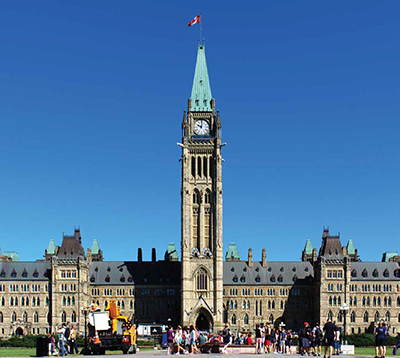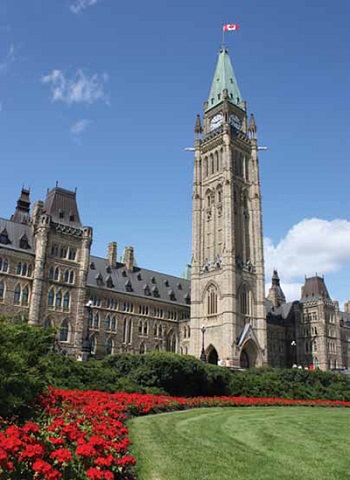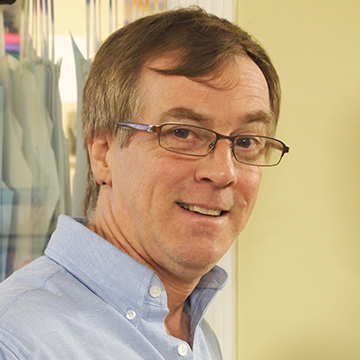The canvas for projecting Canadian history is the Parliament Centre Block in Ottawa, Ontario. Photograph by Francine Douaihy. In the clear summer sunlight, the Canadian Parliament Centre Block in Ottawa, Canada, is a grand stone-and-copper government edifice. Imagine an inverted T: That’s the layout of the structure, with the Peace Tower soaring 302 feet from the building’s center.
But when it gets dark, the Centre Block is transformed into a gigantic video screen unlike any other. Every summer, from July through early September, the National Capital Commission (AKA NCC, the Crown corporation that administers federal lands and buildings in Canada’s capital) delights visitors by presenting the Mosaika sound-and-light show across the facade. This 30-minute show takes the thousands gathered on the Parliament Hill lawn on a journey through Canada’s remarkable history, people, and landscape.
Created by Montreal’s Moment Factory, Mosaika begins with the hands on the Peace Tower clock apparently spinning backwards. Suddenly wind-blown wheat fields appear across the length of the Centre Block, as voices, sound effects, and 5.1 surround sound music fill the air. From there the story of Canada begins. A striking array of colors, videos, hand-drawn animations, graphics, and constant visual movement exploit the natural shape of the canvas—such as turning the Peace Tower into a vertical railway track—and make it disappear. The images seem to dance in space.
The most impressive feature: The Mosaika sound-and- light show is properly scaled to the Centre Block’s massive dimension and Modern Gothic Revival architecture. As strange as an inverted T-shaped video screen may seem, the production works. The proof can be seen online at www.canadascapital.gc.ca/celebrate/mosaika.
Art meets technology
The NCC has been hosting sound-and-light shows on Parliament Hill since 1984. It’s a natural draw for Canadian tourists who flock to the nation’s capital each summer.
Mosaika is the latest show on the hill, having been launched during the summer of 2010. “The visual sophistication of its presentation reflects just how far large-scale audio-visual technology has advanced since the 1980s,” said Boyd Laanstra, coordinator of the NCC’s interpretation programs. “The new high-powered video projectors and outdoor 5.1 surround systems has allowed us to push the medium in new directions and to continue the tradition of creating compelling shows worthy of this landmark setting. We welcome an average of 5,000 spectators each night and no matter where you sit on the front lawns, the show is impressive.”
Amping up history
The numbers associated with presenting Mosaika speak volumes. To tell its story, the production uses 35,000 watts of sound, 27,000 watts of projected video, 80,000 watts of incandescent floodlights, and 14,000 watts of searchlights that reach up to 18,000 feet. The overall display surface requires 16 million pixels; eight times more than a standard HD screen. The total projection surface measures 260-feet tall by 475-feet wide.
To run the show, the NCC’s six-person production crew uses nine Christie Digital projectors. The Peace Tower is covered by three Christie Digital Roadster 18K HD projectors, with their images seamlessly stacked one on top of the other. The left and right wings of the Centre Block are each covered by one Christie Digital Roadster 20K and two 18K projectors; this time with the images set side-by-side.
“It takes 14 computers based in ‘The Bunker’ to run Mosaika,” said Jean-Marc Beauvalet, the NCC’s manager of technical services. “The show, which is timecode-based, is controlled using the Dataton Watchout 4.2 multi-display playback system.” The audio is delivered using Meyer Sound M3D self-powered 4,500-watt loudspeakers, with a couple of Meyer Sound JM-1Ps thrown in for surround sound.

To cope with the Centre Block’s various image-disrupting indents, ornaments, and gargoyles, the Mosaika crew adjusts the video using the Dataton Watchout’s geometry manipulation interface. “It allows us to map the video image to the architectural particularities of the edifice and to help compensate for the physical projector placement,” Beauvalet said.
More suprising stats: Linking together the various pieces of equipment across the Centre Block back to the Bunker requires 5,000 feet of fiber optic cables, plus 50,000 feet of electrical and control wiring. But there’s one statistic that is even more impressive—the number five; that’s how many hours the Mosaika crew has each day to set up, test, and focus the equipment before the show begins.
A tight schedule
The reason the Mosaika crew cannot leave the show’s equipment in place has to do with Parliament Hill’s busy summer daytime schedule. The open lawn in front of the building is constantly in use for public events, including the morning “Changing the Guard’ ceremony, complete with red-coated, busby-wearing soldiers marching with regimental bands and pipers.
“We do keep some major structures in place, such as six hydraulic lifts that support the projectors and moving lights, plus equipment mounted on the Centre Block roof,” Beauvalet said. “But everything else is kept in six trailers, which are brought on site every day five hours before the show starts. That start time is based on sunset. In July, we can’t start until 10 pm. In August, we get to start at 9:30.”
Rain or shine, the NCC’s production crew rolls out its equipment while the tourist are starting to thin out, placing the projectors, setting up the lights and speakers, and laying the cables to six zone-specific nodes that supply power, DMX and signal distribution to the equipment. They get four hours for equipment setup, and just one hour to check the focus and to ensure that the edges between projectors are meshed seamlessly.
“The timing may seem a bit last-minute, but the fact is that we can’t start our setup until it’s dark enough for the images to show up,” said Beauvalet. “Fortunately, our people know their jobs.”
To get ready for the season, this crew gets five days before the first show (this year on July 10) to rehearse setting up and tearing down the equipment onsite. During the Mosaika season, the teardown is scheduled for just two hours. When the season ends, the crew is given a week to take everything down, and three more days to clean it up for storage at the NCC warehouse.
Thanks to a combination of excellent design, pre-show training, and skilled crew members, these tight timelines don’t present too many problems for the Mosaika production crew. But what can be a hassle is the weather: “Contrary to people’s preconceptions about Canada, it can get very hot here in the summer,” Laanstra said. “As a result, evening thunderstorms can happen. We monitor the weather closely each evening and occasionally do have to cancel the show because of rain and for safety reasons.”
This said, tourists visiting Ottawa can count on seeing Mosaika most nights. This is why they travel by the thousands to witness one of the most impressive history lessons in all of Canada.
Equipment List
Christie Digital Roadster HD projectors
Meyer Sound M3D Line Array Speakers
Meyer Sound JM-1Ps Arrayable Loudspeakers
Dataton Watchout 4.2 multi-display playback system
Dataton Watchout geometry manipulation interface
James Careless is an Ottawa-based writer who reports on streaming media and systems integration for AV Technology Magazine.

